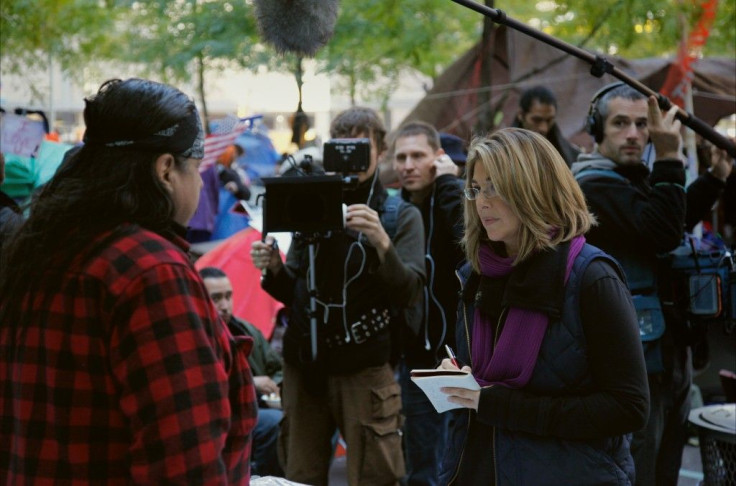Documentary Filmmakers Tap New Distribution Models To Reach Audiences In The Age Of Netflix

If a viewer this week wanted to watch “This Changes Everything,” a new documentary on climate change, she could visit a theater, watch it from home on Apple iTunes or attend a small screening with a local community group. The ability to choose all at once marks a significant departure for the documentary film industry, which has traditionally favored a slower progression, from film festivals to the box office and, eventually, to home viewing.
As was widely reported Friday, Netflix is threatening to upend the traditional release window for theatrical films. The video-streaming giant premiered its new movie “Beasts of No Nation” in theaters and on-demand at the same time, much to the chagrin of multiplex owners who refused to screen the movie out of protest.
But Netflix isn’t alone in experimenting with new ways of getting movies in front of audiences. Documentary producers are also rethinking their distribution models in order to capitalize on the surge in digital video streaming and on-demand viewing. For movies with an activist bent, the all-at-once approach also allows producers to turn their films into rallying tools, ones that can inspire viewers to hold protests and meetings while also boosting overall viewership.
“A lot of people in the distribution world are starting to think about new and game-changing ways to release finds to respond to the way we watch movies these days,” said Avi Lewis, director of “This Changes Everything” and husband of Naomi Klein, who adapted her 2014 book of the same name for the screen. The film launched Tuesday on iTunes in 80 countries and was set to screen in 50 U.S. cities.
“We’re trying to experiment,” Lewis said. “There’s no way of knowing whether this will make more or less money for investors. Everything’s a risk.”
Documentaries typically depend on gathering accolades at film festivals to increase their clout, which in turn sparks interest from distributors and drives buzz among viewers and critics. That approach hasn’t exactly changed; “This Changes Everything” premiered at the Toronto International Film Festival in September. But what Lewis and some other producers are doing is sharply cutting the time frame between the film’s debut and its multiple forms of distribution.
“There used to be a fear that if you released on all those platforms at the same time, they would cannibalize each other” in terms of sales, said Simon Kilmurry, executive director of the International Documentary Association and former executive producer of the PBS series “POV.” “Now there’s an understanding that the audience for TV isn’t the audience that’s going to the theaters, or renting on iTunes. Audiences are demanding multiple ways to access things.”

Documentaries still make up just a tiny slice of overall U.S. movie business. The genre accounted for about 0.85 percent of 2014 gross ticket sales, or $87.8 million out of a total $10.36 billion, according to the Numbers, a movie financial data site.
But the shifting documentary model does reflect a broader trend in the overall film industry, particularly in the U.S., where about 2 in 5 households subscribe to video streaming services like Netflix, Amazon Prime or Hulu Plus, according to a March report from media measurement company Nielsen. With viewers increasingly favoring sitting on the couch, home video streaming is expected to outpace U.S. movie theater receipts within two years, PricewaterhouseCoopers found in a 2014 media outlook report. Electronic home revenues could surge to over $17 billion in 2018, up from $7.34 billion in 2013, the accounting giant said.
Timing And Tie-Ins
Lewis and Klein said they accelerated the rollout of “This Changes Everything” to coincide with the United Nations climate change conference, which runs Nov. 30 to Dec. 11 in Paris. Nearly 200 nations have agreed to forge a pact to slash global greenhouse gas emissions and help vulnerable communities adapt to rising sea levels, extreme weather events and other climate-related effects. The $1.5 million film, which was shot in nine countries over four years, aims to draw a link between rising carbon emissions and our global economic system.
Along with its iTunes release, “This Changes Everything” is already available for community screenings. Organizations pay on a sliding scale, depending on their size, to license the film. Klein said she hoped the documentary and its related social media push could inspire both activists and general audiences to call for aggressive climate action in Paris. Major environmental activist groups, including Greenpeace, 350.org and Friends of the Earth, have organized more than a dozen screenings in Europe. At one event in Amsterdam, the film was projected on a coal-fired power plant. In Australia, the group Get Up! is organizing house parties and screenings ahead of a countrywide climate rally in November.
“We don’t see the film as impacting the negotiations directly. We don’t have that kind of arrogance,” Klein said. “But that kind of mobilization does put pressure on leaders to be more ambitious.”'

Another major environmental documentary, “Racing Extinction,” is similarly striving to draw the public’s attention to the Paris climate talks, although producers pursued a longer distribution time frame. The documentary premiered at the Sundance Film Festival in January and opened theatrically on Sept. 18. The film’s director is Louie Psihoyos, who won an Oscar for his 2009 documentary “The Cove,” about annual dolphin killings in Japan.
Organizations can already license the film for private screenings. On Dec. 2, just three days into the Paris talks, Discovery Channel plans to broadcast “Racing Extinction” in about 220 countries and territories.
“We have aired things globally, but never as this sort of call to action,” John Hoffman, a former HBO producer who is now Discovery’s executive vice president for documentaries and specials, told the New York Times in September. “We have to make this a global event. We have to say to the world, ‘For a moment, we have to stop and look at the issues’ ” that the film raises. A related social media campaign, called #StartWith1Thing, urges participants to make small changes in their daily food, energy and consumption choices to benefit the environment.
Kilmurry, the documentary executive, said filmmakers in the genre are becoming much more sophisticated in engaging with viewers. On top of the conventional question-and-answer session after screenings, directors and producers are using Twitter, Facebook and their films' websites to share additional video clips, host discussions, promote online petitions and share educational materials. Such strategies are key for elevating documentaries above the flood of new films in recent years, Kilmurry said.
“The audience is not distant anymore. The audience is immediate, whether on social media or whatever it might be,” he said. “There's a relationship now that you couldn't have had before.”
© Copyright IBTimes 2025. All rights reserved.





















